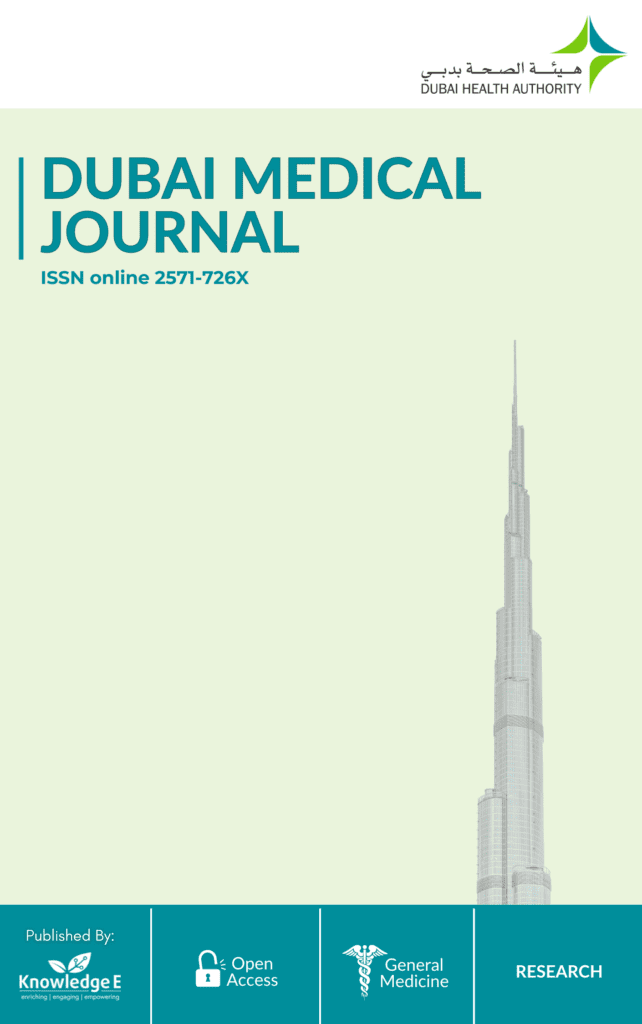
Dubai Medical Journal
ISSN: 2571-726X
Pioneering research in medicine, health sciences, nursing, pharmaceuticals, and laboratory work
Sepsis, Hypothermia, and the Emergence of Osborn Waves: A Case Report
Published date:Nov 21 2024
Journal Title: Dubai Medical Journal
Issue title: Dubai Medical Journal (DMJ): Volume 7, Issue 2
Pages:87 - 93
Authors:
Abstract:
Hypothermia and sepsis are two serious clinical entities with overlapping presentations, both capable of inducing electrocardiogram (ECG) abnormalities. We present a rare case of a 43-year-old male patient with coincident sepsis, acute kidney injury, and profound hypothermia that was complicated by the development of Osborn ( J) waves and conduction abnormalities on the ECG. The patient’s core temperature was gradually restored to normal utilizing both passive and active rewarming techniques, resulting in the disappearance of the Osborn wave. Concurrently, his cognitive state and cardiovascular parameters became stable after intensive sepsis treatment. Osborn waves arise from changes in the action potential and ion channel activity between the epicardium and the endocardium. These phenomena can be detected in several medical circumstances, including hypothermia, sepsis, subarachnoid hemorrhage, Brugada syndrome, and acute coronary syndrome. This case highlights the complexity of the diagnosis and management of such clinical scenarios.
Keywords: sepsis, hypothermia, electrocardiogram, Osborn waves, J waves
References:
[1] Besen HA. Hypothermia. In: Tintinalli JE, Kelen GD, Stapcyzynski JS, (ed). Emergency medicine: A comprehensive study guide. New York: McGraw Hill; 2000. pp. 1231–1235.
[2] De Souza D, Riera AR, Bombig MT, Francisco YA, Brollo L, Filho BL, et al. Electrocardiographic changes by accidental hypothermia in an urban and a tropical region. J Electrocardiol. 2007;40(1):47–52. doi: https://doi.org/10.1016/j.jelectro. card.2006.08.094, indexed in Pubmed: 17027018.
[3] Osborn JJ. Experimental hypothermia; respiratory and blood pH changes in relation to cardiac function. Am J Physiol. 1953 Dec;175(3):389–398.
[4] Gussak I, Bjerregaard P, Egan TM, Chaitman BR. ECG phenomenon called the J wave. History, pathophysiology, and clinical significance. J Electrocardiol. 1995 Jan;28(1):49–58.
[5] Omar HR. The Osborn wave: What have we learned? Herz. 2016 Feb;41(1):48–56.
[6] Clemmer TP, Fisher CJ Jr, Bone RC, Slotman GJ, Metz CA, Thomas FO; The Methylprednisolone Severe Sepsis Study Group. Hypothermia in the sepsis syndrome and clinical outcome. Crit Care Med. 1992 Oct;20(10):1395–1401.
[7] Kushimoto S, Gando S, Saitoh D, Mayumi T, Ogura H, Fujishima S, et al.; JAAM Sepsis Registry Study Group. The impact of body temperature abnormalities on the disease severity and outcome in patients with severe sepsis: An analysis from a multicenter, prospective survey of severe sepsis. Crit Care. 2013 Nov;17(6):R271.
[8] Slovis C, Jenkins R. ABC of clinical electrocardiography: conditions not primarily affecting the heart. BMJ. 2002 Jun;324(7349):1320–1323.
[9] Alhaddad IA, Khalil M, Brown EJ Jr. Osborn waves of hypothermia. Circulation. 2000 Jun;101(25):E233– E44.
[10] Yan GX, Antzelevitch C. Cellular basis for the electrocardiographic J wave. Circulation. 1996;15;93(2):372-379. https://doi.org/10.1161/01.CIR.93.2.372
[11] Maruyama M, Atarashi H, Ino T, Kishida H. Osborn waves associated with ventricular fibrillation in a patient with vasospastic angina. J Cardiovasc Electrophysiol. 2002 May;13(5):486–489.
[12] Maruyama M, Kobayashi Y, Kodani E, et al. Osborn waves: History and significance. Indian Pacing Electrophysiol J. 2004;4(1):33–39. Indexed in Pubmed: 16943886.
[13] Otero J, Lenihan DJ. The “normothermic” Osborn wave induced by severe hypercalcemia. Tex Heart Inst J. 2000;27(3):316–317.
[14] Rudusky BM. The Osborn J wave revisited with reference to the Brugada syndrome. Angiology. 2013 Feb;64(2):161–162.
[15] Zorzi A, Migliore F, Perazzolo Marra M, Tarantini G, Iliceto S, Corrado D. Electrocardiographic J waves as a hyperacute sign of Takotsubo syndrome. J Electrocardiol. 2012;45(4):353–356.
[16] Charles E. DRAKE, Nancy C. Flowers. ECG Changes in Hypothermia from Sepsis and Unrelated to Exposure. Chest. 1980 May;77:5.
[17] Gustavo A. Cardenas, Hector O. Ventura, John E. Francis. Osborn Waves in Sepsis. Southern Med J. November 2006;11(99):1302–1303.
[18] Reuler JB. Hypothermia: Pathophysiology, clinical settings, and management. Ann Intern Med. 1978 Oct;89(4):519–527.
[19] Moore EM, Nichol AD, Bernard SA, Bellomo R. Therapeutic hypothermia: Benefits, mechanisms and potential clinical applications in neurological, cardiac and kidney injury. Injury. 2011 Sep;42(9):843–854.
[20] Paal P, Gordon L, Strapazzon G, Brodmann Maeder M, Putzer G, Walpoth B, et al. Accidental hypothermia-an update: The content of this review is endorsed by the International Commission for Mountain Emergency Medicine (ICAR MEDCOM). Scand J Trauma Resusc Emerg Med. 2016 Sep;24(1):111.
[21] Sessler DI. Complications and treatment of mild hypothermia. Anesthesiology. 2001 Aug;95(2):531– 543.
[22] Austin MA, Maynes EJ, O’Malley TJ, Mazur P, Darocha T, Entwistle JW, et al. Outcomes of extracorporeal life support use in accidental hypothermia: A systematic review. Ann Thorac Surg. 2020 Dec;110(6):1926–1932.